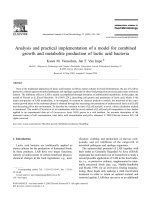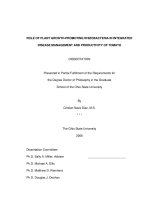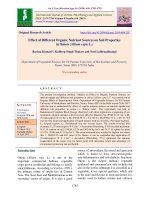Screening of Bradyrhizobial isolates for plant growth promoting properties in vitro conditions
Bạn đang xem bản rút gọn của tài liệu. Xem và tải ngay bản đầy đủ của tài liệu tại đây (163.73 KB, 6 trang )
Int.J.Curr.Microbiol.App.Sci (2018) 7(10): 2232-2237
International Journal of Current Microbiology and Applied Sciences
ISSN: 2319-7706 Volume 7 Number 10 (2018)
Journal homepage:
Original Research Article
/>
Screening of Bradyrhizobial Isolates for Plant Growth Promoting
Properties in vitro Conditions
R. Naveen Kumar* and R. Subhash Reddy
Department of Agricultural Microbiology and Bioenergy; College of Agriculture, Professor
Jaya Shankar Telangana State Agriculture University, Rajendranagar,
Hyderabad - 500 030, Telangana, India
*Corresponding author
ABSTRACT
Keywords
Soybean [Glycine
max (L.) Merrill],
Bradyrhizobia,
Rhizobia
Article Info
Accepted:
18 September 2018
Available Online:
10 October 2018
Plant growth promoting rhizo-bacteria (PGPR) affect plant growth by producing and
releasing secondary metabolites (plant growth regulators/phytohormones/biologically
active substances), facilitating the availability and uptake of certain nutrients from the root
environment and inhibiting plant pathogenic organisms in the rhizosphere. At the same
time, plants produce root exudates containing e.g. sugars, amino acids, organic acids,
vitamins, enzymes and organic or inorganic ions. Those substances in turn influence the
rhizosphere microflora and also the behaviour of PGPR. In this work, I examined the
potential use of legume bacteria, rhizobia as PGPRs since it has been shown that rhizobia
(legume bacteria) can function as PGPR in nitrogen fixing plants. The present
investigation is carried out with the objective of isolating Bradyrhizobia from different
areas of soybean growing fields of Adilabad district and treating these isolates with the
nitrogen fixation responsive soybean variety, for selecting the best isolate. Fourteen
Rhizobial isolates were obtained from different areas, purified and authenticated based on
their morphological, cultural, biochemical characters and nodulation test. All the fourteen
isolates showed checked for IAA, phosphate solubilizing activity, Siderophore production
and HCN production. Among all isolates SBR-8 showed positive in all PGPR activities.
Introduction
Soybean [Glycine max (L.) Merrill] a legume
native to East Asia has made a significant
contribution to the yellow revolution in India.
Starting from 3000 ha in India during 1969
soybean has shown steady increase in area
over the years. At present India ranks fifth in
both area and production in the world and
Madhya Pradesh is a leading state in both area
and production in India. In Madhya Pradesh,
soybean occupies an area of 57.300 lakh ha
with 61.666 lakh million tonnes production
with average yield of 1076 kg ha-1 during
Kharif
2010-11
(Soybean
Processor
Association, 2011).
Together, soybean oil and protein content
account for about 60% of dry weight of
soybean: protein at 40% and oil at 20%. The
remainder consists of 35% carbohydrate and
about 5% ash.
Soybean
fixes
atmospheric
nitrogen
2232
Int.J.Curr.Microbiol.App.Sci (2018) 7(10): 2232-2237
biologically in its root nodules symbiotically
in association with specific rhizobia. Rhizobia
are soil bacteria that fix nitrogen (diazotrophy)
after becoming established inside root nodules
of legumes Rhizobia require a plant host
because they cannot independently fix
nitrogen. Morphologically, they are gram
negative, motile, non-speculating rods. B.
japonicum is slow growing, nitrogen fixing
bacteria that forms asymbiotic relationship
with soybean. It insists the formation of
nodules in the plant root system. Plant root
colonizing bacteria can function as harmful,
deleterious rhizobacteria (DRB) or beneficial,
plant growth promoting rhizobacteria (PGPR).
Rhizobacteria that inhibit plant growth have
been described as deleterious rhizobacteria.
Plant growth promoting rhizobacteria (PGPR)
are root associated soil bacteria that can
facilitate plant growth and development in two
diverse ways: directly or indirectly (Glick,
1995: Glick et al., 1999). The direct
promotion of plant growth by PGPR generally
boost up plant growth by providing the plant
with a compound that is synthesized by the
bacterium or facilitating the uptake of
nutrients from the environment.
A number of authors have reported that
inoculation with plant growth promoting
rhizobacteria (PGPR) can result in increased
germination and seedling emergence and
modify growth and yield of various cereal and
non-cereal crops (Freitas and Germida, 1992;
Chen et al., 1994; Matiru and Dakora, 2004;
Wang et al., 2007). The growth stimulation in
plants by PGPR can be a direct effect of
production of secondary metabolites such as
auxins, IAA, cytokinins, riboflavin and
vitamins (Dakora, 2003). These stimulate
growth of plant organs via cell division and
expansion (Campanoni et al., 2003) or by
improving nutrient availability. They also
release organic acids, which help to make
available forms of nutrients (Biswas et al.,
2000) and often lead to increased plant growth
through uptake of water and mineral nutrients
or indirect when the rhizobia inhibits
pathogens or deleterious microorganisms by
producing siderophores,
Majority of Indian soils are essentially devoid
of efficient Bradyrhizobium japonicum. Direct
isolation of efficient strains from soil is
difficult from the native rhizobial population.
It was thought to be ideal to isolate cultures
from effectively nodulated soybean plants.
Local rhizobial isolates usage as inoculants
were also found to be more effective.
Therefore, effective rhizobia need to be
identified from among local rhizobial isolates
for soybean for effective symbiotic association
and thereby obtaining high yields, improved
soil fertility and better environment.
Though soybean cultivation has been
introduced in Adilabad district, the crop has
failed to establish in many places. One of the
reasons for this could be due to the absence of
soybean specific indigenous rhizobial strains
in the soils. Hence, it was decided to isolate
strains of rhizobia from soybean, purify and
screen them for their ability to nodulate so that
the most efficient strains could be cultured on
a mass scale and supplied to farmers.
Materials and Methods
Isolation of bacterial isolates
Root nodules collected from different local
varieties of soybean crop growers from
Telangana by method as described by Vlassak
(1992) on the selective media plates i.e. Yeast
Extract Mannitol Agar (YEMA) and incubated
at 30ᵒC for a period of 24-72h.
Characterization of bacterial isolates
The isolates that were likely to be Rhizobium
colonies were picked up from the YEMA
plates and proceeded\ for confirmation by
2233
Int.J.Curr.Microbiol.App.Sci (2018) 7(10): 2232-2237
studying the cultural, morphological and
biochemical examination as given below.
Cultural Characterization
After incubation, cultures were studied for
their colony characters such as size, shape,
margin, consistency, pigmentation etc. as per
Bergey’s
Manual
of
Determinative
Bacteriology (Holt et al., 1994).
Morphological characters
Purified cultures were further studied for their
cell morphology viz., Cell shape, Cell
arrangement, response to the gram stain.
Screening for plant growth promoting
properties of bacterial isolates
Phosphate solubilisation
This test will be performed following spot
inoculation of pure isolates on Pikovskaya’s
medium (Pikovskaya, 1948).
The diameters of the clearing zones around the
colonies were measured.
Pure isolate will be tested by inoculating on
succinate agar using alkaline picric acid as a
reagent (Castric and Castric, 1983). Brown
colour of the filter paper positive for HCN
production.
Results and Discussion
Two or three healthy pink nodules were
collected from each plant and surface
sterilized by using 0.1% HgCl2 and 70%
ethanol as described in Material and Methods.
The nodules were crushed and streaked on
YEMA medium plates containing congo red
dye. The colonies from each nodule were
purified by streaking 2-3 times on same
media. In total fourteen Rhizobial isolates
were obtained from different places. These
isolates were further purified and maintained
on YEMA slants for further studies.
The bradyrhizobia isolates were checked
based on morphological characters for purity,
labeled and maintained on YEMA slants. The
Rhizobial isolates were labeled as mentioned
in Table 1.
Production of plant growth promoting
substances
Indole acetic acid production
IAA production will be tested in succinate
broth using orthophosphoric acid as a reagent
for color development (Duby and Maheswari,
2012). Pink colour of the medium and quantity
of IAA production measured by the standard
graph analysis.
Siderophores production
Production of siderophores will be estimated
qualitatively on aqueous Ferric chloride
solution for siderophores detection (Schwyn
and Neilands, 1987). Orange colour hallow
zone around the colonies.
Hydrocyanic acid production
Plant growth promoting substances such as
auxins, gibberellins, ethylene substances
produced by plant growth promoting
rhizospheric bacteria. These are directly
involved in plant growth promotion. In the
present study fourteen isolates were screened
for indole acetic acid production for selection
of efficient growth promoting bacterial strain
(Table 2).
Indole acetic acid production
Effect of IAA in plants is significant and some
of them are apical dominance, phototropism,
gravitrophism, prevention of leaves and fruit
2234
Int.J.Curr.Microbiol.App.Sci (2018) 7(10): 2232-2237
abscission and induction of adventitious root
system. Therefore IAA has profound influence
on crops. Production of IAA was observed
with the supplementation of L-Tryptophan @
10 mg per liter by all fourteen bacterial
isolates.The bradyrhizobial isolates SBR-4,
SBR-5, SBR-6, SBR-7, SBR-8, SBR-9, SBR10, SBR-11, SBR-13 and SBR-14 produced
IAA while other isolates SBR-1, SBR-2, SBR3 and SBR-12 did not produce IAA (Table 2).
Pikovskya’s medium such as SBR-5, SBR-6,
SBR-7, SBR-8, SBR-9 in Table 2.
All the bradyrhizobial isolates were tested for
their plant growth promotion properties like
phosphate solubilization and for biocontrol
property like siderophore and HCN production
also and the results are presented in Table 2.
Since siderophore production is attributed as
one of the mechanisms of biocontrol activity
of the plant growth promoting rhizobacteria,
siderophore production was observed on 0.2%
aqueous Ferric chloride solution.
Phosphate solubilization was studied by
observing the clear zone on Pikovskya’s
medium. Some of the bradyrhizobial isolates
showed phosphate solubilization activity on
Some of the bradyrhizobial isolates produced
siderophores viz., SBR-1, SBR-2, SBR-3,
SBR-8 and SBR-12 in Table 2.
In the present study IAA production and
phosphate solubilization by PGPR isolates
agreed with the earlier reports are available on
PGPR strains which were isolated from wheat
showed IAA production ranging from 5.5-31.0
μg mL-1 (Abbasi et al., 2011). Hussain and
Srinivas (2013) isolated
Table.1 Bradyrhizobial isolates from different parts of Adilabad district
Place of sample collection
Bradyrhizobial isolate
Dhanor (b)
SBR-1 & SBR-2
Devapur
SBR-3
Indervelly
SBR-4 & SBR-5
Gaurapur
SBR-6 & SBR-7
Utnoor
SBR-8 & SBR-9
Muthnor
SBR-10 &SBR-11
Bersaipet
SBR-12
Salewada
SBR-13
Ponnari
SBR-14
2235
Int.J.Curr.Microbiol.App.Sci (2018) 7(10): 2232-2237
Table.2 Cultural and physiological characterization of the bradyrhizobial isolates from the
soybean growing fields of the Adilabad district
Isolate name
IAA production
SBR-1
SBR-2
SBR-3
SBR-4
SBR-5
SBR-6
SBR-7
SBR-8
SBR-9
SBR-10
SBR-11
SBR-12
SBR-13
SBR-14
+
+
+
+
+
+
+
+
+
+
Phosphate
solubilization
–
–
–
–
+
+
+
++
+
–
–
–
–
–
Siderophore
production
+
+
+
++
+
-
HCN
production
–
–
–
+
–
+
–
+
+
+
–
–
–
+
Note: + show for positive, - shows for negative
The bradyrhizobial isolates SBR-4, SBR-6,
SBR-8, SBR-9, SBR-10 and SBR-14
produced IAA while other isolates SBR-1,
SBR-2, SBR-3 and SBR-12 did not produce
HCN (Table 2).
Similar results were also reported by
Ponmurugan and Gopi (2006) who found that
phosphate solubilizing bacteria (PSB) isolated
from the rhizosphere of different field crops
including maize, were capable of producing
auxin under in vitro conditions.
The various isolates of bradyrhizobia isolated
from the soybean plant nodules collected
from different regions of Adilabad district
were screened under pot culture experiment
with good Bradyrhizobium responsive
soybean variety J.S-335.
The bradyrhizobial isolates were obtained and
identified based on morphological, cultural
and biochemical characters. They were
screened for production of phosphate
solubilization,
IAA
and
siderophore
production. Pot culture experiments were
conducted to study the Bradyrhizobium
responsive soybean variety and best
Bradyrhizobial isolate suitable for nitrogen
fixation responsive soybean variety. The
salient findings of the experiments conducted
are given below:
Bradyrhizobia isolated from the soybean
fields of different areas of Adilabad district
were purified.
Fourteen bradyrhizobial isolates from
different regions of Adilabad district were
identified as Bradyrhizobium and nine isolates
are used in further studies.
All the bradyrhizobial isolates were slow
growing and alkali producers. Based on the
results obtained in the present study, it can be
summarized that the J.S-335 soybean variety
is highly responsive to inoculation of
bradyrhizobial isolate SBR-8.
2236
Int.J.Curr.Microbiol.App.Sci (2018) 7(10): 2232-2237
References
Biswas, J. C., Ladha, J. K., and Dazzo, F. B.
(2000a). Rhizobia inoculation improves
nutrient uptake and growth of lowland
rice. Soil Sci. Soc. Am. J. 64, 16441650.
Campanoni, P., Blasius, B., and Nick, P.
(2003). Auxin transport synchronizes
the pattern of cell division in a tobacco
cell line. Plant Phys. 133, 1251-1260.
Chen, Y., Mei, R., Lu, S., Liu, L., and
Kloepper, J. W. (1994). The use of yield
increasing bacteria asPGPR in Chinese
agriculture. In “Management of Soil
borne diseases” (U. K. Gupta and R.
Utkhede, Eds.), Narosa Publishing
House, New Delhi, India.
Dakora, F. D. (2003). Defining new roles for
plant and rhizobial molecules in sole
and mixed plant cultures involving
symbiotic legumes. New Phytol. 158, 39
– 49.
DeFreitas, J. R., and Germida, J. J. (1992).
Growth promotion of winter wheat by
fluorescent Pseudomonas under growth
chamber conditions. Soil Biol. Biochem.
24, 1127-1135.
Glick, B. R. (1995). The enhancement of
plant growth promotion by free living
bacterial. Can. J. Microb. 41, 109-117.
Glick, B.R., Patten, C.L., Halguin, G.,
Rensose, D.M., (1999) Biochemical and
genetic Mechanisms used by plant
growth promoting bacterial collage
press. London, U.K. pp 267-269.
Matiru, V. N., and Dakora, F. D (2004).
Potential use of rhizobial bacteria as
promoters of plant growth for increased
yield in land races of African cereal
crops. African J. Biotechnol. 3, 1-7.
Pikovskaya R L 1948 Mobilization of
phosphorus in soil in connection with
vital activity of some microbial species.
Microbiology 17: 362 – 370.
Schwyn B and Neilands J B 1987 Universal
chemical assay for detection and
determination
of
siderophores.
Analytical Biochemistry 16: 47 – 56.
Wang, C., Saldanha, M., Sheng, X., and
others. (2007). Roles of poly-3hydroxybutyrate (PHB) and glycogen in
symbiosis of Sinorhizobium meliloti
with Medicago sp. Microbiology 153,
388-398.
How to cite this article:
Naveen Kumar, R. and Subhash Reddy, R. 2018. Screening of Bradyrhizobial Isolates for Plant
Growth Promoting Properties in vitro Conditions. Int.J.Curr.Microbiol.App.Sci. 7(10): 22322237. doi: />
2237









